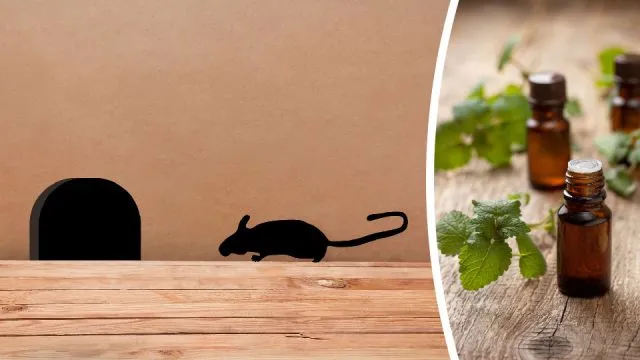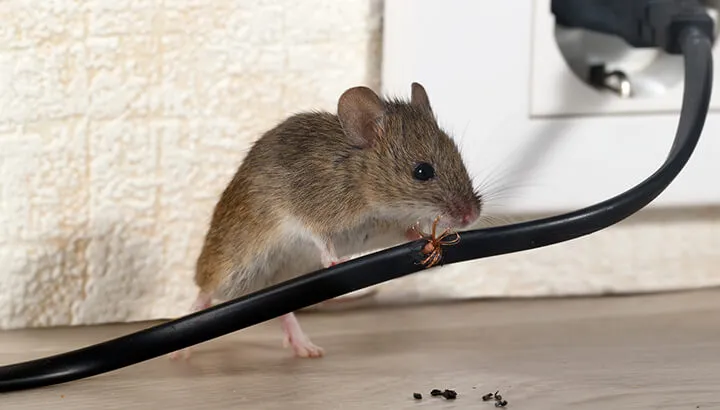
- Share on Facebook147
- Share on Pinterest
- Share on Twitter
We have a family cottage, and it is definitely our little slice of heaven. Surrounded by lush trees, it’s not uncommon to see bears, deer or even wolves crossing the ice in the winter. With all of this wildlife around us, you bet that we find a mouse or two indoors each year.
Mice never creeped me out and to be honest, I think they’re quite cute. However, there are some serious concerns surrounding the illnesses that they carry. They also love to chew on things — the type of things that could cause house fires.
So, whether you like mice or not, we can’t coexist within our homes.
There are many options to get rid of mice, some of which are more humane than others. That is why I want to take you on a little mice removal journey. You can get rid of these little creatures and they can go on to live their lives… outside of your home. Well, unless you have a cat.
The dangers (and inconveniences) surrounding mice

When you think about a tiny mouse, you may think, can they really be that dangerous? The short answer is, yes they can.
A threat to both your health and home, these tiny rodents also breed rapidly. Two mice can quickly turn into ten. That is why you want to take immediate action when you notice any signs of these critters, especially droppings.
Just some of these dangers include, but are not limited to:
- The contamination of food and cooking surfaces due to urine and droppings
- The possibility of spreading bacteria and disease
- Damage to household items, ranging from furniture to clothing
- An increased risk of an electrical fire due to the chewing of wires
Natural options to get rid of mice today
You’ll often hear people say in business, “I built a better mousetrap” — as in, they redeveloped something that is already in existence (and in this case, you can too). When taken literally, there are many mouse traps available and they can be effective. However, both traps and poison ignore the root of the problem.
Related: Repel These 5 Household Pests Naturally
If you have a pest problem, including mice that are now residents of your home, traps are not only inhumane but are often ineffective long-term. Ignoring issues surrounding reproduction, it is important to implement a more sustainable strategy.
Home remedies not only work, but they’re often as natural and non-toxic as can be. If you have children or pets, home remedies are particularly an ideal solution.
1. Peppermint oil

I’m a big fan of essential oils. They’re so versatile and can be used for just about anything around the house — including the removal of mice. Although a whiff of peppermint is typically pleasing for humans, mice aren’t fans. Although this will not technically remove mice from your home, it will act as a preventative remedy.
Using pure peppermint oil, soak some cotton balls and place them around potential routes of entry. If you’re often in and out of your back door while gardening in the fall, create a peppermint oil spray. For every cup of water, combine two to three teaspoons of peppermint oil. Give the area a good spray daily. Some also swear by a homemade “pepper spray” made with habaneros.
Added bonus: Peppermint oil also deters ants, spiders, mosquitoes and even cockroaches.
2. Cuddle up with a cat

Of course, I am not saying go out and get a cat just because you have mice problems, but if you were in the market for one, hey-ho! Acting as a natural predator, cats are one of the most effective ways to get rid of mice. Although it’s not nice to find a dead mouse on your porch, this cycle of life could not be any more natural.
Tip: The best mice-hunting cats are typically those that live both indoors and out. If you have a rather chubby cat that likes to sleep all day (and has never been outside), it may not be keen on stalking and hunting prey.
3. Steel wool

Remember, mice can fit through tiny holes (as small as a quarter of an inch). That is why you’ll want to seal up crevices with steel wool, as it is the one material that mice can’t nibble through. Check for any cracks or holes in your home’s foundation or walls. Also have a good look around doors, windows, vents, and utility lines. Where it makes sense, install screens — otherwise, seal areas with either steel wool or caulking.
4. Purchase or build a nest box for owls
Barn owls hold a special place in my heart. In Ontario, their official status is endangered. Already extirpated (no longer found) in the state of Michigan, barn owl numbers are also declining throughout the northeastern and midwestern region of the United States.
The good news? A pair of barn owls and their brood can eat up to 3,000 rodents in a nesting season. You can actively help this species while implementing a natural rodent control strategy — all you need is a nest box. Before you buy or build your own, check out this video from the Barn Owl Trust: How to Choose the Best Barn Owl Nest Box Design.
Nothing beats prevention
There are a number of natural mice-repellent solutions out there, but when it all boils down, nothing beats prevention. This spring, declutter areas of your home that would make a perfect breeding ground for little critters. Also, plant natural scents in your garden that repel rodents, including lavender, daffodils, and mint. These flowers can also help support the needs of bees.
So, before you grab a toxic poison, consider your options.
Moral of the story: Work in harmony with nature and you’ll be rewarded with a mouse- and chemical-free home.
— Krista Hillis
- Share on Facebook147
- Share on Pinterest
- Share on Twitter

